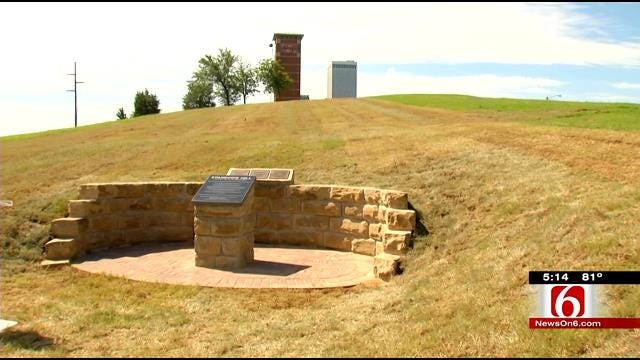New Historical Marker Cites Role Standpipe Hill Played In Race Riot
Historic records detail how Standpipe Hill was a witness to one of the darkest times in the city's history and are included on the new marker.<br />Thursday, June 12th 2014, 12:12 pm
The University Center at Tulsa Authority and Oklahoma State University-Tulsa recognized a significant location in Tulsa history during a historical marker dedication on Thursday.
"Standpipe Hill played a role in the tragic unfolding of the Tulsa Race Riot, which had a lasting impact on this area of our city," OSU-Tulsa President Howard Barnett said in a news release. "The ceremony will remember the lasting impact of that event and other historical events that happened at Standpipe Hill and look at the role it continues to play in Tulsa as part of OSU-Tulsa."
The marker, which will be located south of John Hope Franklin Boulevard between Detroit Avenue and Martin Luther King Jr. Boulevard, details the history of Standpipe Hill, the role it played during the Tulsa Race Riot, its significance as home to higher education offerings in Tulsa and the hopes for the community's future development.
5/22/2012 Related Story: 'Dad' Clark, Oldest Known Tulsa Race Riot Survivor, Dies
"The dedication is a time for our community to come together and remember the tragic history of this area and its influence on Tulsa," said Glenda Love, chair of the Standpipe Hill Historical Marker Committee and an OSU-Tulsa trustee. "Remembering the past will help us move forward in a spirit of reconciliation to create a more prosperous future for all of Tulsa."
Historic records detail how Standpipe Hill was a witness to one of the darkest times in the city's history, the 1921 Tulsa Race Riot, which resulted in the death of many black people and the destruction of much of the Greenwood District, OSU-Tulsa officials said.
A news release says the historical marker committee examined historical documents and researched legends associated with Standpipe Hill to determine what factual information to include on the marker.
"There are many historical events and legendary stories associated with Standpipe Hill," Barnett said. "While many things are verifiable by historical documents, photos and eyewitness accounts, others remain more difficult to authenticate. Our goal was to create a concise narrative that details what happened here."
Legendary stories include tales of the Dalton gang using the top of the hill as a vantage point to spot lawmen to see if it was safe to attend church nearby.
The city's first water tower, which gave the Standpipe Hill its name, was constructed in 1904. The tall, cylindrical unit was demolished in 1924 when a new water storage unit was constructed on Reservoir Hill just a few miles north.
The University Center at Tulsa, a consortium of higher education institutions including OSU, was established on land adjacent to Standpipe Hill in the 1980s. The campus became OSU-Tulsa on Jan. 1, 1999.
The Standpipe Hill historical marker was designed by Kinslow, Keith and Todd architecture firm and built by Flintco. The stones used in constructing the pedestal and wall of the marker were preserved from the historic stones that supported the foundation of the hill.
The text on the plaque reads as follows:
In 1904 the City of Tulsa built a water tower in the shape of a stove pipe. Thus, Standpipe Hill was named.
To the east, the Greenwood community would grow and prosper, providing the success of "Black Wall Street."
The Race Riot of 1921 resulted in the death of many African-American people, the destruction of hundreds of homes and the burning of churches and businesses in Greenwood. All of this could be seen from atop Standpipe Hill.
From the seeds of overwhelming destruction, African-Americans moved back and rebuilt. But this rebirth of Greenwood would give way to suburban flight and urban renewal.
In the 1980s a new vision was conceived. Land east and north of the hill was dedicated to public higher education for all Tulsans and the region.
More to come…
History Remembered and a Future to be Embraced
Dedicated June 2014
To what has been and what will be...
More Like This
September 29th, 2024
September 17th, 2024
Top Headlines
November 23rd, 2024
November 23rd, 2024
November 23rd, 2024
November 23rd, 2024












